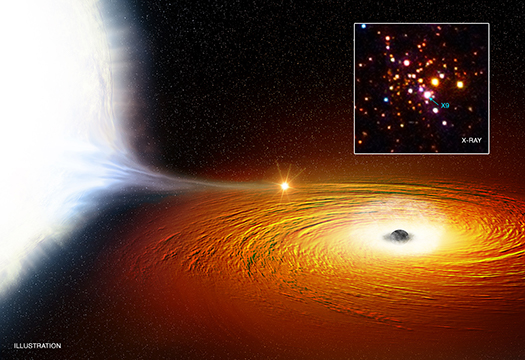For Release: March 13, 2017
CXC

Credit: X-ray: NASA/CXC/University of Alberta/A.Bahramian et al.; Illustration: NASA/CXC/M.Weiss
Press Image and Caption
Astronomers have found evidence for a star that whips around a black hole about twice an hour. This may be the tightest orbital dance ever witnessed for a likely black hole and a companion star.
This discovery was made using NASA's Chandra X-ray Observatory as well as NASA's NuSTAR and CSIRO's Australia Telescope Compact Array (ATCA).
The close-in stellar couple — known as a binary — is located in the globular cluster 47 Tucanae, a dense cluster of stars in our galaxy about 14,800 light years from Earth.
While astronomers have observed this binary for many years, it wasn't until 2015 that radio observations with the ATCA revealed the pair likely contains a black hole pulling material from a companion star called a white dwarf, a low-mass star that has exhausted most or all of its nuclear fuel.
New Chandra data of this system, known as X9, show that it changes in X-ray brightness in the same manner every 28 minutes, which is likely the length of time it takes the companion star to make one complete orbit around the black hole. Chandra data also shows evidence for large amounts of oxygen in the system, a characteristic feature of white dwarfs. A strong case can, therefore, be made that the companion star is a white dwarf, which would then be orbiting the black hole at only about 2.5 times the separation between the Earth and the Moon.
"This white dwarf is so close to the black hole that material is being pulled away from the star and dumped onto a disk of matter around the black hole before falling in," said first author Arash Bahramian of the University of Alberta in Edmonton, Canada, and Michigan State University in East Lansing. "Luckily for this star, we don't think it will follow this path into oblivion, but instead will stay in orbit."
Although the white dwarf does not appear to be in danger of falling in or being torn apart by the black hole, its fate is uncertain.
"Eventually so much matter may be pulled away from the white dwarf that it ends up only having the mass of a planet," said co-author Craig Heinke, also of the University of Alberta. "If it keeps losing mass, the white dwarf may completely evaporate."
How did the black hole get such a close companion? One possibility is that the black hole smashed into a red giant star, and then gas from the outer regions of the star was ejected from the binary. The remaining core of the red giant would form into a white dwarf, which becomes a binary companion to the black hole. The orbit of the binary would then have shrunk as gravitational waves were emitted, until the black hole started pulling material from the white dwarf.
The gravitational waves currently being produced by the binary have a frequency that is too low to be detected with Laser Interferometer Gravitational-Wave Observatory, LIGO, that has recently detected gravitational waves from merging black holes. Sources like X9 could potentially be detected with future gravitational wave observatories in space.
An alternative explanation for the observations is that the white dwarf is partnered with a neutron star, rather than a black hole. In this scenario, the neutron star spins faster as it pulls material from a companion star via a disk, a process that can lead to the neutron star spinning around its axis thousands of times every second. A few such objects, called transitional millisecond pulsars, have been observed near the end of this spinning up phase. The authors do not favor this possibility as transitional millisecond pulsars have properties not seen in X9, such as extreme variability at X-ray and radio wavelengths. However, they cannot disprove this explanation.
"We're going to watch this binary closely in the future, since we know little about how such an extreme system should behave", said co-author Vlad Tudor of Curtin University and the International Centre for Radio Astronomy Research in Perth, Australia. "We're also going to keep studying globular clusters in our galaxy to see if more evidence for very tight black hole binaries can be found."
A paper describing these results was recently accepted for publication in the Monthly Notices of the Royal Astronomical Society and is available online. NASA's Marshall Space Flight Center in Huntsville, Alabama, manages the Chandra program for NASA's Science Mission Directorate in Washington. The Smithsonian Astrophysical Observatory in Cambridge, Massachusetts, controls Chandra's science and flight operations.
A labeled image, a podcast, and a video about the findings are available at:http://chandra.si.edu
For more Chandra images, multimedia and related materials, visit:
http://www.nasa.gov/chandra
Media contacts:
Megan Watzke
Chandra X-ray Center, Cambridge, Mass.
617-496-7998
mwatzke@cfa.harvard.edu



Visitor Comments (3)
Absolutely spectacular. I had no idea that a planet could form from a depleted white dwarf. I love this site.
Posted by Todd Vance on Monday, 11.6.17 @ 15:46pm
Bravo. Fabulous findings.
Posted by Gizmo on Thursday, 05.25.17 @ 12:06pm
Great work by Chandra as we explore the universes to make ourselves whole.
Posted by Surendra Pratap Singh on Tuesday, 03.14.17 @ 14:42pm